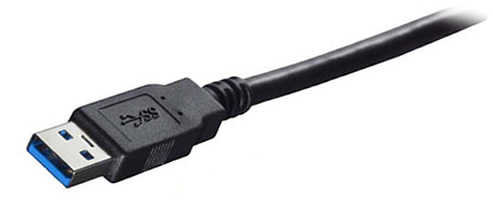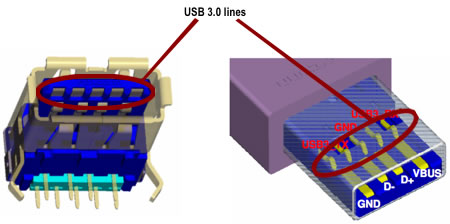USB 3.0: What You Need To Know
The Universal Serial Passenger vehicle standard has come a long fashion since its introduction in 1996. Backed past a consortium of companies led by Intel, Compaq and Microsoft, it offered some unheard-of features for its time, including the ability to connect peripherals without turning off the figurer first and to draw ability without a separate Ac connection. The standard became popular with the arrival of version ane.1 in late 1998, assuasive a maximum transfer rate of 12Mb/due south, and as we can witness nowadays just about any device comes standard with 'Hi-Speed' USB 2.0 connectivity.
USB iii.0 is the next major revision of the ubiquitous interface. Dubbed SuperSpeed USB, this new version promises a tenfold spring forward in transfer speeds as well equally improved capabilities, all while maintaining compatibility with USB ii.0 devices. In the following few paragraphs nosotros've rounded out all the relevant information that you as a consumer should know about the next-generation USB standard.



Some quick facts about USB 3.0
It's fast. The new standard breaks the 480Mb/s data transfer limit of USB two.0 and takes it to a new theoretical maximum of four.8Gb/s. Proceed in mind that real-world operation can exist considerably lower than that. USB three.0 devices are not expected to attain their total potential at launch, only every bit the standard matures the USB-IF considers it reasonable to achieve a throughput of 3.2Gb/s, or just about enough to transfer a 27GB high definition motion picture in little over a minute rather than 15 or more with USB two.0.
It's bi-directional. Unlike previous versions where data can only be piped in i management at a fourth dimension, USB 3.0 tin read and write information simultaneously. This is achieved by calculation two new lanes defended to transmit SuperSpeed data and another pair for receiving it, bringing the full number of connections from four on USB 2.0 (power, footing and two for sending/receiving not-SuperSpeed data) to nine counting the 3.0 ground contact.
Furthermore, the signaling method, while yet host-directed, abandons device polling in favor of a new interrupt-driven protocol. This ensures that the USB host controller doesn't continually admission a continued device in apprehension of a data transfer. Instead, USB three.0 devices will ship the host a signal to begin a data transfer.
It's more ability efficient. The signaling method mentioned direct above likewise means that non-active or idle devices won't accept their power drained past the host controller as it looks for agile data traffic. Minimum device operating voltage is dropped from 4.4 V to 4 V. On the other hand, the USB-IF has upped the maximum coach power output from most 500 mA to 900 mA, which will enable power-hungrier devices to be bus-powered and USB hubs to support more peripherals. There'due south also the bonus that bombardment-powered devices should charge faster.
It's backwards compatible. Your existing USB 2.0 gear will piece of work on version 3.0 ports and vice versa. You'll exist able to maximize your bandwidth when using a USB 3.0 cablevision with USB iii.0 devices and ports, otherwise plugging a 3.0 device into a 2.0 port or a two.0 device into 3.0 a port volition get you standard USB two.0 data rates.

Since the new interface has been carefully planned from the start to peacefully co-exist with its predecessor, the connector itself remains mostly the aforementioned with the four USB ii.0 contacts in the exact same location as earlier. Extra pins for the new lanes dedicated to transmit and receive SuperSpeed data are located on the back and simply come into contact when mated with a proper USB iii.0 port.

The receptacle is deeper as a consequence of this and USB three.0 plugs will be longer than existing ones to accomplish the rear contacts. Besides, due to the use of additional wires the new cable volition be about every bit thick as an Ethernet cable.
Available and upcoming products, price points
Afterwards co-creating the USB 3.0 Promoter Grouping more than than two years agone, and existence criticized for allegedly blocking hardware partners from accessing needed information, Intel finally released the Extensible Host Controller Interface in August 2008. This meant that other members of the USB 3.0 Promoter Group would be able to start developing their own solutions once the finalized spec was made available.

Unfortunately Intel itself has no plans to support the technology on their own chipsets until at to the lowest degree 2022, property back mainstream adoption, simply NEC has a single-chip solution on the marketplace correct now known equally the µPD720200. The chip measures x ten 10mm, consumes upwardly to 1W and is priced at $fifteen in bulk quantities.
Motherboards
Several board manufacturers have been relying on NEC'due south host controller for calculation USB three.0 functionality to their products. Asus has iv variations of the P7P55D-E for Intel LGA 1156 (Lynnfield) processors, with prices ranging from $180 to $280, as well as the $300 P6X58D Premium for Intel LGA 1366 (Bloomfield) fries. Gigabyte also has four boards currently available as part of its P55A branded series priced between $135 and $250. Also the GA-X58A-UD7 for $350 and a pair based on AMD'due south 790X and 790FX chipset each going for $140 and $185, respectively.

MSI is known to exist working on at least 1 USB three.0-equipped P55 motherboard, the P55-GD85, and another based on AMD's forthcoming 890FX chipset which is expected to arrive in the 2nd quarter of next twelvemonth.
Devices
It might take at least a couple more than years until we see the market for USB 3.0 devices really explode. High-bandwidth devices will naturally exist amid the first to drift to the new interface, simply cost considerations, which are mainly driven by demand and volume, will restrict implementation to higher-end products for now.

As of this writing we know of just a handful of devices offering support for USB 3.0 and near of them are prohibitively priced for the average user. Super Talent, for case, has unveiled a line of thumb drives that will debut with a 64GB model priced at $400. The promised 320MB/s transfer speeds sure are tempting, though.
Buffalo'south newest external hard drive, the DriveStation Hd-HXU3, steps into a slightly more reasonable price point with the 1TB model to start selling for $200 and the 2TB version for a whopping $400. The company has too announced a USB 3.0, 12X Blu-ray burner which should sell in Japan at a cost equivalent to $451.

Nosotros expect several other devices to be announced in little over a week at the Consumer Electronics Evidence (CES) in Las Vegas, including an external solid-country drive from OCZ and a dual-drive RAID storage solution from LaCie, both based on a new Symwave storage controller. At that place volition also exist several USB 3.0-infused DisplayLink products at the show and a number of other products from all the usual suspects -- nosotros'll brand certain to go along you upward to engagement in our coverage when the information becomes available (and updating this guide as required).
Adapter cards
Adapter cards volition probable play an important function in driving the installed base of USB iii.0 ports up. Instead of shelling out upwards of $150 for a new USB iii.0-equipped motherboard, users would need to spend roughly $30 to $l for a 2-port PCI Limited card compatible with their current hardware.
Information technology should be noted that Windows seven doesn't have native back up or drivers for USB iii.0, but Microsoft intends to deliver them in an upcoming update to the operating organisation.
Source: https://www.techspot.com/guides/235-everything-about-usb-30/
Posted by: vangorderwhout1940.blogspot.com


0 Response to "USB 3.0: What You Need To Know"
Post a Comment